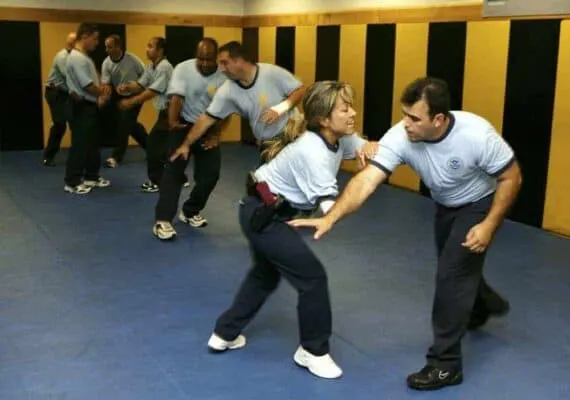
On average, U.S. police officers learn some elements of combat arts while in the police academy, but police officers do not undergo any advanced hand-to-hand combat training. As such, many police officers take martial arts classes outside their job to improve their self-defense skills. So, what are the best martial arts for police officers to improve their self-defense skills and protect others?
The best martial arts for police officers are Krav Maga, BJJ, wrestling, MMA, Muay Thai, and boxing, which have been proven effective in real life. Learning these martial arts will improve a police officer’s ability to handle threats more intelligently, reducing the use of deadly force in the end.
The following are the top six martial arts that have been proven to be effective. Training in the following martial arts can boost police officers’ self-defense skills by more than a couple of weeks of hand-to-hand combat training at the academy. So let’s take a look!
1. Krav Maga
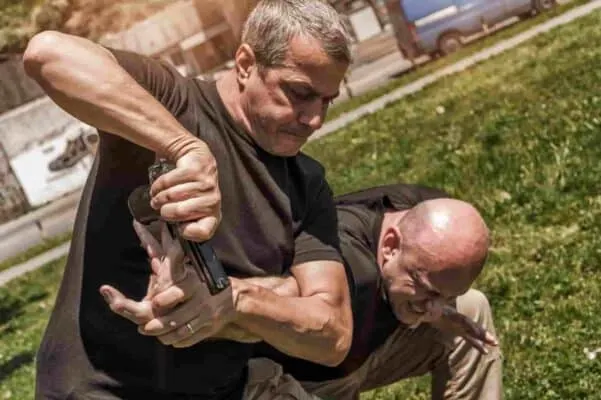
Krav Maga is a self-defense martial art created by the Israeli military in the 1950s. It is a comprehensive system designed to prepare a person for various types of combative situations and is very beneficial for police officers.
Training involves grappling, striking, dirty tactics(techniques for survival), and even weapons like knives and firearms. On top of that, students learn how to deal with multiple attackers, fight in various places and surroundings, and many other valuable skills.
Nowadays, millions of people worldwide, including police officers, practice Krav Maga. The power and effectiveness of training lie in the fact that the entire focus of the system is on the physical and mental aspects of real combat. It trains you to:
- Stay calm under pressure
- Assess the situation you are in
- Make rational calls
- Escape out of trouble in the fastest and most efficient way possible.
First, Krav Maga instructors would teach you verbal skills so that you can try and talk your way out of the fight. If that does not work and the conflict gets physical, then applying one of many grappling and striking moves is key. Most of the techniques you learn in Krav Maga are to be executed explosively, aiming to finish or subdue the attacker as fast as possible.
In most schools, the instructors do an excellent job of simulating real fighting scenarios. While in training, out of the blue, they would start yelling and insulting you, provoking, attacking from behind, and doing many other things to play with your emotions and reactions. Though this is too much for most people, this brutal training realism is the main reason so many police officers train in Krav Maga.
| Advantages of Krav Maga for police | Disadvantages of Krav Maga for police |
| • An all-around system that entirely focuses on self-defense. • Includes weapon-based training and dirty tactics, and defending against multiple attackers. • Teaches you all about the physical and mental aspects real fighting. | • The emphasis is on defense and running away from the attacker. • There is not much sparring. • The quality of classes and methods of teaching vary too much between schools around the world. |
RECOMMENDED READING: Are U.S. Police Trained in Martial Arts? Police Training Q&A
2. Brazilian Jiu-Jitsu(BJJ)
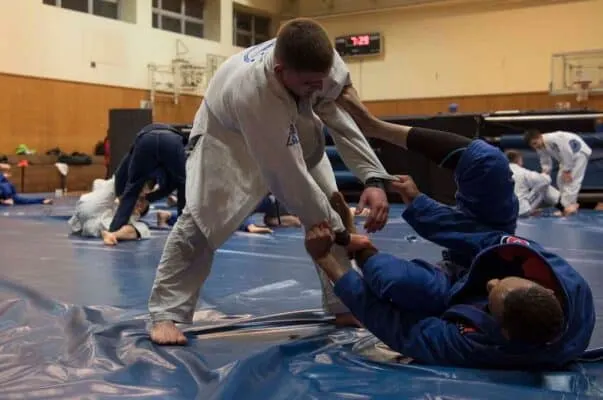
Brazilian Jiu-jitsu(BJJ) is widely regarded as one of the best martial arts for police officers. It is a practical system that enables you to subdue a suspect most efficiently and safely. Yes, BJJ trains you to put the suspect in a joint lock or choke, which may result in broken bones or other injuries. But, exactly how much force to apply to the suspect is at the discretion of the police officer. In most cases, just securing a dominant position over the suspect is enough to subdue them.
BJJ has many variations like Gi and No-Gi. But the most effective form of Brazilian Jiu-jitsu and the one that is most practical in the line of duty for police officers is “Gracie Jiu-Jitsu.” This form mainly focuses on the self-defense aspect and how to apply BJJ moves in various scenarios you may face on the streets. Gracie Jiu-jitsu teaches police officers to deal with a street fight situation where there are no rules to follow or win matches and medals. No, the Gracie system is all about using BJJ to defend yourself.
Many police officers train in BJJ because this is the only martial art that teaches you how to deal with a suspect without causing serious injuries. On top of that, it is one of the rare systems that enables physically smaller people to defeat bigger and stronger opponents by focusing on leverage, balance, and technique. All of this makes BJJ skills a must-have if you are a police officer.
| Advantages of BJJ for police | Disadvantages of BJJ for police |
| • Practical system that allows you to subdue a suspect without causing injuries. • Focus is on leverage and technique. • The injury rate is quite low. • It was designed with self-defense in mind. | • No striking, weapon-based training or dirty tactics. • You have to be careful when applying chokes and joint locks because you can easily hurt the suspect. • Takes a lot of time to master (around 10 years) • Cannot handle multiple assailants |
LEARN MORE Get the full report on What’s the Difference Between Gracie Jiu-Jitsu and BJJ?
3. Wrestling
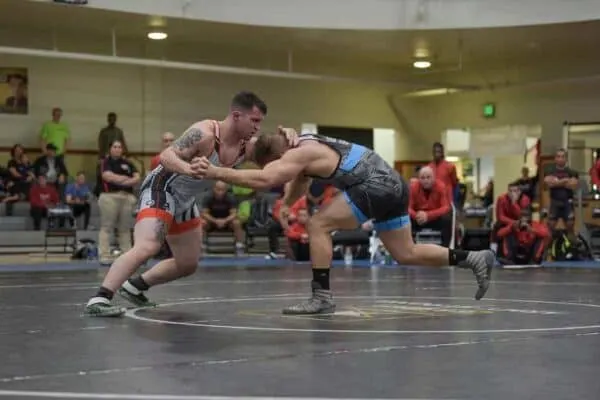
Wrestling skills are one of the most effective styles in any type of freestyle combat, which is why there are so many skilled wrestlers among police officers. Look at modern MMA fighting if you need proof of how practical wrestling is in a real fight against other fighting styles. Of course, most police officers face situations differently than in MMA matches, but the concept remains the same.
Wrestling is all about leverage, technique, balance, positioning, and weight distribution. It doesn’t include any striking, and the entire focus is on taking the fight to the ground as fast as possible with takedowns, trips, and throws—the best thing about it is that most people don’t know how to defend against wrestling attacks. So it wouldn’t make much difference even if the suspect is trained in boxing, BJJ, or Muay Thai.
Instead of using elevated use of force against the suspect who is putting on resistance, the more effective and safer way might be to change your tactic and land a takedown. This gives a police officer a strong top position from which they can subdue the suspect and put on the handcuffs. There is less chance of causing physical injuries, and it is almost impossible for the attacker to escape from the bottom.
| Advantages of wrestling for police | Disadvantages of wrestling for police |
| • Allows you to quickly get a dominant position over the suspect without causing injuries. • Average people, regardless of strength and size don’t have the ability to defend against wrestling attacks. • A lot of sparring which helps you develop good automatic reactions | • Wrestling is a popular combat sport where you won’t learn advanced self-defense tactics. • The lack of striking, weapon-based training, or verbal tactics. |
RECOMMENDED READING: Why Do Wrestlers Dominate MMA?
4. Mixed Martial Arts(MMA)
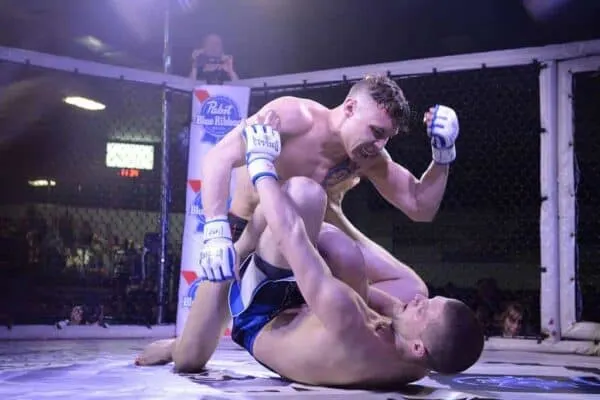
Mixed Martial Arts(MMA) is the most versatile combat sport where fighters are allowed to mix striking and grappling together. It is a mix of only the most effective techniques from the following martial arts put into one system:
- Muay Thai
- boxing
- BJJ
- Wrestling
Many police officers can be seen training in MMA since this is the only combat art that will prepare them to fight against all different types of fighting styles. It covers all the ranges on the feet, grappling in the clinch, and fighting on the ground. However, MMA trains you to obey the rules and win matches, not to control the suspect. But as far as the effectiveness of the techniques is concerned, MMA is top-notch.
Yes, it doesn’t teach you how to deal with weapons, verbal tactics to de-escalate the situation or any other self-defense tactics. But, not a single martial art out there would teach you a better combination of grappling and striking moves and how to apply those in a real fight.
| Advantages of MMA for police | Disadvantages of MMA for police |
| • A versatile combat system that covers all the ranges and places. • Includes only the most practical techniques. • Improves mental resistance and overall fitness. • Gives you a big advantage in any type of fight. | • The emphasis is on aggression and causing injuries. • It is a bit limited because MMA is a combat sport that teaches you how to compete under the rules |
LEARN MORE Get the full report on 10 MMA Fighters that are or were Police Officers
5. Muay Thai
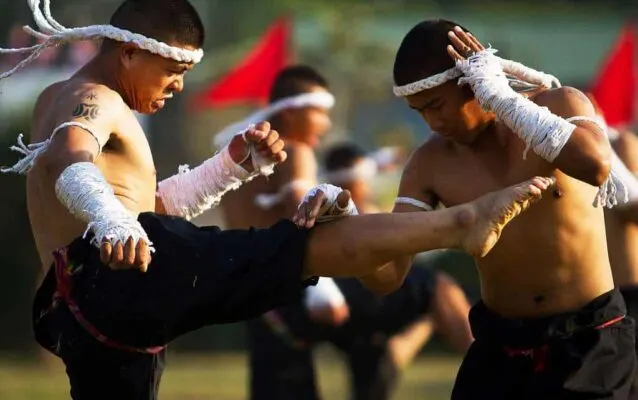
Muay Thai is a famous martial art from Thailand and is an excellent option for police officers looking to develop proper striking skills. The entire concept revolves around using all of your eight limbs as weapons in a fight to strike with: kicks, punches, knees, and elbows.
The system covers all the ranges, including the clinch from which you can pull basic grappling moves like trips, throws, and sweeps. On top of that, training emphasizes hard sparring and developing quick automatic reactions and instincts.
Muay Thai is a versatile system, and it is great for police officers because it trains you to fight at all ranges on your feet. No matter if the suspect decides to throw a punch, kick, or grab your uniform in an attempt to take you down, you will have the weapons and skills at your disposal to deal with the situation in a very efficient way.
For example, the famous “Thai clinch” is one of the most effective moves in any type of fight. If the suspect tries to get a hold of you or comes too close, you will know how to wrap your hands around their neck to break their posture and get into a dominant position.
However, remember that Muay Thai is an aggressive system that you are supposed to use as a last resort. You won’t learn advanced verbal tactics to avoid conflict or how to control the suspect.
| Advantages of Muay Thai for Police | Disadsvantages of Muay Thai for police |
| • Covers all the ranges on the feet. • Trains you to use all eight limbs as weapons to strike or defend. • Includes a lot of hard sparring. • Improves reflexes, reaction time, and awareness. • Covers the basics of grappling. • Intense training that improves fitness and conditioning | • It doesn’t include advanced self-defense tactics. • The emphasis is on causing damage with hard striking which is the wrong approach for police officers. • It trains you to compete under Thai boxing rules. • There is no grappling or ground fighting |
RECOMMENDED READING: Is Muay Thai Good For Self-Defense? A Beginner’s Guide – FAQ
6. Boxing
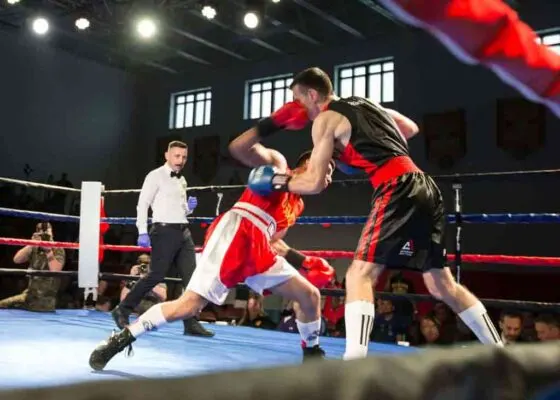
At first sight, boxing might not seem like an ideal option for police officers for two main reasons. First, it is limited to some extent because it focuses “just” on striking with your fists. Second, it is an aggressive fighting style where the main goal is to knock your opponent out or cause serious injuries with hard shots. For this reason, as a police officer, applying boxing techniques may appear to be excessive use of force to handle a resisting suspect.
But why are there so many police officers training in boxing then? Some countries, like the UK even have a “Police Boxing Association.” Boxing can help you a lot on the streets for one simple reason.
In any type of fight, the most common way of attacking is by throwing a punch. If the suspect decides to attack the police officer, they will, in most cases, use their hands to do so. No one would bother to throw wild kicks or go for a double leg takedown, notably average people not trained in martial arts.
No, the fastest and most efficient way possible to hurt a person standing in front is by throwing a punch. Thus, all police officers should know how to defend against these commonly occurring hand strikes and learn how to counter-punch(must be justifiable) to defend themselves in some cases. On top of that, training is cardio intense, improves fitness, and will keep you in top shape.
| Advantages of boxing for police | Disadvantages of boxing for police |
| • The best martial art when it comes to hand attacks. • Great for improving both mental and physical toughness. • Teaches great blocks and head movement | • One-dimensional system that focuses just on strike. • It is a combat sport that trains you to fight under the rules. • Emphasis on damage and injuries |
RECOMMENDED READING: Is Boxing Good for Self Defense? The Ultimate Answers
Related Questions
What martial arts do FBI agents learn?
FBI recruits train at the FBI Academy in Quantico, Virginia, where they receive some training in hand-to-hand combat in case they have to defend themselves. While at the academy, FBI recruits learn how to approach suspects who may or may not be combative. Recruits also learn various defensive tactics and how to apply the appropriate use of force based on the totality of circumstances. Some of the training FBI recruits undergo the following:
- Getting familiar with violence and how it feels like to be in a fight
- Practice various arresting techniques.
- How to control the suspect on the ground
- Self-defense techniques from martial arts like Krav Maga, Judo, jiujitsu, and striking.
As such, FBI recruits do not train to become martial arts experts, which is one of the biggest misconceptions. If the FBI agents wanted to become better fighters, they would have to do that on their own time by taking martial arts classes.
What is Verbal Judo? (The Art of Fighting Without Fighting)
“Verbal Judo” is a federally copyrighted and trademarked system that teaches police officers how to communicate tactfully with their suspects to make them more compliant without using force.
Even though this system is not a real martial art, it’s still a very effective art of persuasion that all police officers should learn to make confrontational suspects more calm and compliant without first using the use of force to subdue them.
Many police agencies in the United States already teach verbal judo techniques to their new recruits in police academies.
Officers learn how to approach the suspect in a non-threatening way, keep their tone low, and pick the right words to de-escalate the situation. The founder of this art of persuasion was George Thompson, and he believed that the most dangerous weapon is the tongue:
“We know that the most deadly weapon we carry is not the .45 or the 9mm, it is in fact the cop’s tongue … A single sentence fired off at the wrong person at the wrong time can get you fired, it can get you sued, it can get you killed,” said Thompson.
The Guardian
Words and the right approach are, in many cases, more effective than any other martial arts technique in resolving a heated, violent situation.
